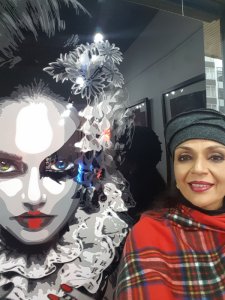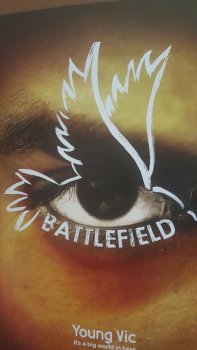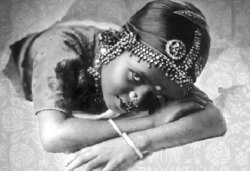
|   |

|   |
March 1, 2016  "Secure your pension but don’t you dare give up on your passion." - Dancer and bureaucrat Ananda Shankar Jayant at the Harvard India seminar, Cambridge, USA Landing a few hours ago from my first US /UK trip this year has meant that my fingers, toes, face and hands are still thawing from a historically cold Polar February! While throwing off my layers of winter warmers, my thoughts race across the many kinds of performances I watched in the past two weeks. A verbal recap below... ALWIN NIKOLAIS, a dance tribute-Joyce Theatre, NYC A terrific homage to a multi talented choreographer, visual designer, dancer, costumer and one of the original polymath dance artistes. Historic works remounted on younger dancers, memories flashed of the 1968 India tour of the Murray-Nikolais company’s tour of India. TENSILE, performed with the famous stretch bands and neon spandex tights were astonishing 48 years ago and continued to draw a standing ovation in 2016. A reminder that great choreography can live on younger bodies and legacy can be bequeathed in a sensitive manner. FUERZA BRUTA NYC A racy, breathless spectacle of aerial dancers, billowing silver curtains, suspended swimming pools over the standing audience’s heads and pounding drums was tailor made for the twenty somethings and a screaming rock music crowd. Whew! THE CHERRY ORCHARD, Brooklyn Academy of Music, NYC Anton Chekov’s most famous play about class and changing times, performed in Russian with English supertitles, was ponderous, melodramatic and hard to watch. However, returning to the beautiful BAM theatre and marveling at the roster of amazing artistes who will grace the theatre this year was inspiring. The first time I entered this space was to watch Mallika Sarabhai as Draupadi in Peter Brook’s 9 hour transcription of THE MAHABHARATA in 1988. HIPPOLYTUS, Cockpit Theatre, London A truly imaginative adaptation of the Greek classic using Javanese music, Kechak pneumonics, Balinese dancing and Greek lyrics showed how stories that converse in multiple “languages” can still speak to urban audiences. Directed by Yana Zariki, it proved that the human condition of power, lust, ego and betrayal was worthy of continued examination across centuries. THE BATTLEFIELD, Young Vic, London  The long awaited return to THE MAHABHARATA in the aftermath of the great war was Brook at his stark and brilliant best. Much like Chandralekha’s SHARIRA which represents the distilled art of the late choreographer in silence drenched choreography, BATTLEFIELD was wonderful. 5 actors interchanged roles, interpreted the many layers of storytelling that layer the main story and used the amazing Japanese musician Toshi Tsuchitori providing a moving score of emotive percussion. The final long silence while his fingers caressed, struck, glided, stroked and pounded the surface was poignant enough to remind us that man would continue to be drawn towards the futility of war through time. Storytelling theatre at its best. This show comes to Bombay in a few days and I would urge all dance and theatre practitioners to rush to see it. No fancy pyrotechnics here. Just superb acting, The larger question is will Indian audiences accept actors from Ireland, Rwanda, USA, France and Japan play the roles of Kunti, Dhirdarashtra, Bhishma and Yudhishtira? Three decades ago, the India tour of THE MAHABHARATA was cancelled amidst huge protests of Brook’s multiracial casting. While each of the shows left me with varied responses, the last two that I watched in London, proved that cultural transcreation, if done with respect and integrity, can cross boundaries and converse with multiple generations. #THE NUMBERS GAME Group choreography is nothing new for the dance world but when soloists, who have spent more than 40 years developing and honing their solitary presence on stage to international acclaim, begin to work with bodies beyond themselves, one has to watch and question. Will there be fresh ideas that extend beyond the single dancer? What does group/ensemble work entail? A multiplying of bodies to emphasize effect? Mere AFFECT? A ruse to camouflage aging, slowing expanding contours with a sprinkling of nimble dancers? The classical format was originally constructed on individual bodies until Rukmini Devi and Uday Shankar created the "corps de ballet" inspired formations for their famous choreographies. Mrinalini Sarabhai brilliantly re-imagined multiple dancers to mount her issue based productions. Since 1975, the State sponsored tourism festivals (Khajuraho, Ajanta, Ellora, Konark, Mahabalipuram) have forced guru-choreographers to locate their dance designs onto large ensembles against the imposing architecture. Often the beautiful heritage backdrops also camouflage childish dance arrangements and the seduction is complete with audiences mesmerized with the locales rather than the performance itself. More and more solo dancing gurus are adding numbers to their repertoire. Some work with students. Others are contracted dancers who are taken on for a specific project. Yet others are being mentored by diva soloists. With larger and larger groups being in demand for cultural export, it seems only logical that various styles located on a plethora of dancing bodies is the easiest GO TO choice of somnambulic government organizations. The success of Leela Samson’s CHARISHNU, Madhavi Mudgal’s SANKRITI, Anitha Guha’s SUNDARA KHANDAM, Ananda Shankar Jayant’s NAVARASA and now Geeta Chandran’s MADHURA makes group work a fool-proof formula for extensive touring and guaranteed crowds. Choreographing is one aspect. HOLDING THE GROUP TOGETHER is a whole new set of uphill climbs. Ask Aditi Mangaldas who has struggled with her well trained ensemble deserting her before the coveted tour of Australia. A hint of stardom / instant TV fame and WHOOSH, dancers are out of the door in a flash! #BHOOMITANGO Bhoomi/Land is the one commodity that cannot be manufactured or created. There is only so much land on this planet and the stakes are zooming with each breath. What is happening to the prime land in Kalakshetra? Are the rumours of a giant conglomerate expressing interest in developing portions of the coveted land to be believed? Will there be a new state of the art cultural complex on the lines of Esplanade in Singapore? Will it carry a branding of the corporate entity? Will the incomplete Koothambalam undertaken by Leela Samson during her tenure as director, ever get completed? While the weaving and textile department of Rukmini Devi’s visionary cultural space gets a much needed revival, many wondered at the purpose of the recently concluded Choreography Festival. Curated by director Priyadarsini Govind, the well attended event left many wondering at the uneven standards of selection. The special ambience inside Kalakshetra continues to be very special. There is a gentle whisper that is unspoken as we remove our footwear at the entrance and enter the cool stone floor of the space. Dancers appear better in the old world framing of the thrust low rise stage. Yet, that was not enough to disguise the surprisingly uneven standards of artistes’ selection for the festival. While Chennai and the annual music/dance festival continue to awe and interest the diaspora, the centre of Bharatanatyam excellence is fast moving away from my home town! Take a look at the roster of names that fill classical dance festivals around India and the world. Note how many dancers are not from Tamilnadu!! Carnatic music, meanwhile, flourishes. #NEW CULTURE MAG We welcome the launch of cultural patron Minaakshi Dass’ new magazine VIBRANT CULTURE to selected outlets in New Delhi. Any print space dedicated to the arts is welcome. I had high hopes for a Kolkata magazine called AVANTIKA that started with great promise and folded in two years. Starting is one thing...Sustaining is quite another... #HIDDEN GEM Can I share a secret about a hidden theatre jewel in Tamilnadu? It is not in Chennai, the self appointed dance capital of India. It is tucked away in Manjakudi, near Trichy - the village being the birthplace of the social reformer and spiritual seer Swami Dayanand Saraswati. Over the past 18 years a huge revolution has occurred in the fields of education, health and social reform. And music and dance has been at the centre of the education system. A gorgeous auditorium, complete with lighting grids, green rooms, high ceilings, dance floor and professional support is in place. In Manjakudi. Not Chennai. An annual dance festival has been mounted each year and the famous performing artistes who arrive in that quiet village are first astounded with the facilities and then deeply moved by the warmth and positive vibrations of the environment. All the brainchild and efforts of one woman - Sheela Balaji! She admits that she is not an artiste or a rasika in the pure sense but a dynamo organizer and manager. May her tribe increase! #KNOW YOUR HISTORY  Instead of empty saber rattling that describes most of the dance politics in India, will it not be better to take a leaf out of the school curriculum of the German school books in Nuremberg? In the city smudged with the dark history of the Reich, young Germans are taught the horrors and mistakes of the Hitler era. Nothing is whitewashed or glossed over. No detail or ugly incident neglected. Photos, articles and facts are taught as part of German history. Students are told that they cannot waive this distressing fact by saying “that happened in another time.” Contrast this with the amnesia of the USA, whose history books have conveniently forgotten the genocide of Native Americans and a nation built on the backs of slavery. Pitch this alongside the selective memory of Indian dance history. Throw up the image of the Mohenjodaro dancing girl but “forget” to mention the cultural extermination of the devadasis. An entire community wiped out over a systematic collusion of colonial and local class politics. How can we even stand in the first position of ‘sama padam’ with our hands on our waists without acknowledging those women who made it possible for us to do so today? And why should we say that the era is long over and that we have nothing to do with it? It is part of our history and we bear a collective responsibility. Are any of the horrific incidents taught in Dance History classes? Dominated by upper class students and teachers, this aspect of India’s cultural past is never discussed or even mentioned. Selective memory and double speak at the fore! #CROC TEARS There is a recent spate of articles and declarations about the Isai Vellalars (traditional community of musicians, teachers and performers) that fill the slot for cultural reporting in online magazines. What is the reason to bring HER up again and again? The once glorious and admired artiste is now an object of pity, distorted history and empty sympathy. What about the hypocritical double speak of our national heroes? Do we know that Mahatma Gandhi refused to accept the donations of some devadasis who sold their jewellery for the freedom struggle? In a talk by Canadian dance historian Davesh Soneji, it was revealed that the Father of the Nation turned this group of women away who had come to see him by saying that their money was “tainted”! While any attention to a forgotten chapter of dance history is important, what is needed is an objective and updated account of the tragic rise and fall of this traditional community against the backdrop of Indian nationalism of the 19th and 20th century. Until then, the excellent NITYA SUMANGALI (Published in 1987) by Dr. Saskia Kersenboom continues to be the handbook of history of the community. I wonder if urban presenters will consider inviting a devadasi artiste to present her original repertoire? Will she fit the "accepted" visual aesthetic that has become the unspoken standard for dance? Will the Madras Music Academy permit the slum children that Carnatic vocalist TM Krishna proudly says he is teaching to be presented on their hallowed stage? Although the tone of the various articles range from remorse, partial facts and reflective regret, it seems to be a contentious and problematic issue for dance historians and anthropologists. The eradication and sidelining of an entire group of people by dilettante hobbyists of the upper caste is a dark blot on our cultural history. It is ours to know, acknowledge and pass on. The tragedy of our dance is that we have allowed the false layers of religiosity and spirituality as sacrosanct watchdogs to the art. Most of our classical performers walk around with “halos” surrounding them and glare at anyone who dares offer objective comment. As musician Anil Srinivasan says, “No wonder Indian dance and music is forever wrapped up in gauzy glitter and shoved to the exotic pavilion!" #AKADEMI IN LONDON It is not just me who is fed up with the recent craze for workshops and item learning mania. Even arts managers and funders are irritated with the empty eagerness of dancers who flock for a weekend course in adding to the menu card. Finally, UK arts agencies are refusing to give in to dancers’ demands to learn from famous teachers. MILAPFEST in Liverpool and AKADEMI in London are focusing on creating professional training and higher standards for UK dancers. Mira Kaushik who heads AKADEMI has led the way with several dance initiatives - NAVODIT, CHOREOGATA, DAREDEVAS and other interesting projects that are nudging, pushing, prodding classical dancers to reach out via mentors to expand their choreographic imaginations. Funding R&D grants, helping dancers from short sharing to fleshing out ideas into full length works, organizing a UK touring pattern - these are all enormously useful and positive ways in which MIRA/AKADEMI are working towards a new pathway for classical and contemporary British Indian dance. I have known AKADEMI’s work for the past 16 years since COMING OF AGE, a stunning outdoor celebration at the South Bank Centre, and have watched this Delhi theatre aficionado work stubbornly and sometimes with exasperation at the stubborn mindsets of classical dancers. The problem we all agree is the gurus and the global affliction of the “AKKA” and “AUNTY” syndrome! The ways in which today’s teachers are shaping dance bodies and minds while failing to maintain the professional distance between teacher and student. #MILAP IN LIVERPOOL  In my first ever visit to the music capital of UK, Liverpool, I was pleasantly surprised at the developments at the MILAPFEST office. Founded by the doctor couple Prashant and Geeta Nayak, MILAPFEST has become a nationally recognized arts organization for music, choirs, and classical dance intensives with master teachers from India. Their ten year old DANCE INDIA summer sessions have been so popular that students clamour to enroll each year to learn from great gurus from India. Yet even THEY have become aware of the limitations of the “item learning” syndrome. So, against great opposition and dropping numbers from their students, MILAPFEST is thinking ahead and steering their dance vision towards “process” based learning. Their cultural calendar is filled with a dizzying range of programmes, scholarships and festivals. I was invited to inaugurate their SANNIDHI lecture series at their new facilities located within the HOPE UNIVERSITY’s CREATIVE CAMPUS. Amidst a sea of students, all immersed in design, craft, dance, theatre and visual arts, MILAPFEST has a dream team of MBAs, funding managers, advisors, teachers with a fully equipped CAPSTONE THEATRE literally a door away! My audience was largely the dance and theatre department and the talk was about how the craft, technique and ‘language’ of Bharatanatyam could be translated into multiple genres and varied responses to words, music and moods across time. Using examples of Andal (Tamil 9th century), Akka (Kannada 12th century), Meerabai (Braj 16th century), Dikshitar (Sanskrit 18th century), John Lennon (English 20th century), Salvatore Adamo (French 20th century) and Adele (English 21st century), I demonstrated how the body moves, inflects and pulses using a learned technique and acknowledging that Somatics must be included in the mindful adaptations across cultures, languages and genres. Of course, this was NOT what I would advocate to young Indians as a way into pseudo experimentation or “contemporary” dance, but instead a mode to examine what the learned tradition gives us as our bodies imbibe a certain “muscle memory” learned and practiced for 20, 30, 40 years. A way to “converse" with the present. To be creative, one has to be on top of one’s form. Unless you are supremely comfortable with the technique, one cannot release from this springboard to leap into other areas. And failure is a must. An absolute imperative for new ideas to be born. The SANNIDHI lecture was adapted to suit the young and impatient non-Indian audience (ages 18 to 21) who were, thankfully, gripped and interested throughout my two hours of talk, dance, singing and showing. Most had seen Kathak and Bharatanatyam and all had known about Bollywood. And EVERYONE admired Akram Khan. Almost all had seen the COLD PLAY video ‘Hymn for the weekend’ with Beyonce as "rani" doing her version of the Indian-Hindoo dance! However, none of the questions were trite or silly. The girls admitted that they found the costumes and jewelry “gorgeous and sexy”, the boys said they were fascinated with the footwork ('tatti mettu' to Adele’s FIRE TO THE RAIN). These kinds of interactions in academic environments are what I truly enjoy. Young minds, bludgeoned with technology and yet choosing creative careers need to be celebrated. Dwindling audiences for the live arts are directly related to the lack of leisure time in our lives. If money and lifestyle are the only goals then museums, theatre and galleries will be depleted of the human warmth. University environments like HOPE LIVERPOOL are shining lights in this global gloom of fear, suspicion, cynicism and envy. MILAPFEST is very fortunate to be located in such a vibrant city where the arts, especially music, is such an acknowledged presence. #DEBATE AND DISSENT All these monthly musings seem pointless against the outrageous response by the State against the agitating students at JNU, New Delhi. Debates and discussions in college cafes, impassioned rhetoric at elections, flirtation with ideologies and politics is a natural and important part of student life. The national sentiment has galvanized students of all faiths and castes to come together to protest. If only we could have the cultural community band together to discuss the many important issues that affect the arts fabric of India. The cloth is being torn. The seams ripped. Threads are hanging loose, the quilt is coming apart. A new method of quilting is required. One that holds us together across the universe. As artistes, empathic about each other. Who care about the present and the future. In 1910, before he fled Kolkata for Pondicherry to escape incarceration for sedition against the British, philosopher and seer Sri Aurobindo wrote about the hope of India. That she of all the nations of the world had the opportunity and the capacity to become a leader of the world. In this scenario of daily unrest, strikes, caste wars and public destruction, it is increasingly difficult to keep the faith of those words. #SPRING FEVER The colors of Holi, the magic of Khajuraho’s dance festival and the annual Sivaratri tour for emerging talent… the dance carousel refuses to stop. Meanwhile, the Tyagaraga festival in Cleveland, USA has become an important first step for hundreds of musicians and dancers. Having participated 22 years ago, I notice its growing influence amongst Carnatic musicians all over the USA. Congratulations to Mr. Sundaram and his team! March 6 is Mother’s Day in the UK. March 8th is International Women’s Day everywhere. To all those wonderful women - mothers, dancers and sisters who will mark these special days - here is a big, warm cyber hug as we segue through our various avatars in life and art; as we cheer our sorority of doers, dreamers and dare-devis! Feminist nod to the film SUFFRAGETTE, a moving true story of British women who fought for the right to vote! Unmissable! DIVERSITY DEBATE With DIVERSITY being the buzzword at the Oscars, we should pause and be realistic about what our world is like today. In my ten days in New York and London, I was served by a Russian barista, driven by a Scottish cab driver, served by a Chilean bartender, had a makeover by a Polish designer, was lectured by a Mexican philosopher, photographed by a German photographer and had an acupuncture session by a Chinese doctor. This is our world today. Bharatanatyam and Kathak are now global forms and art makers like Peter Brook recognized it 4 decades ago before it became acceptable. Ultimately it is about making the connection. Of being able to communicate and share. The Oscars reminded us that no matter what mode we employ - we are all riveted by the art of storytelling. By a campfire or a glitzy auditorium, to 1 or 1000, stories are what we all do best - through sound, movement and image. Let us not forget that!  Meanwhile, Chennai has turned into a large outdoor photo exhibition. The Biennale has transformed so many spaces and it is a feast for the eyes to see the art of photography having evolved into a distinct form of its own! I hope dancers find the time to visit any one of the numerous exhibitions in the city. Until we meet again! Dr. Anita R Ratnam Chennai/ Bombay/ Colombo/ Kuala Lumpur Twitter: @aratnam Facebook: Anita R Ratnam Instagram: @anitaratnam Blog: THE A LIST / anita-ratnam.blogspot.in Post your comments |